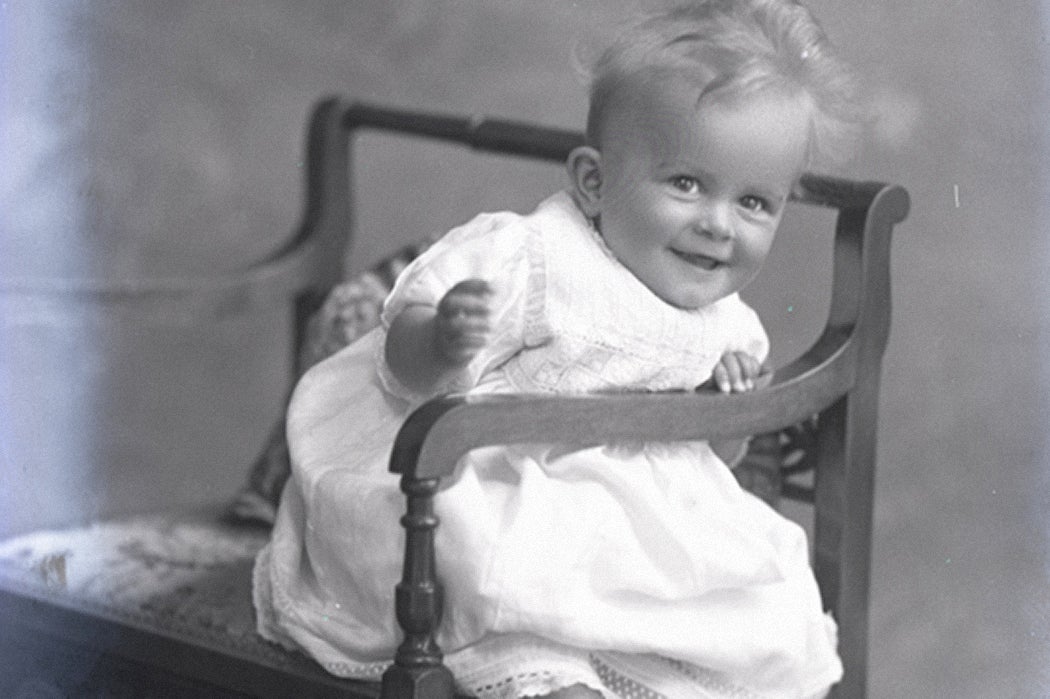Exploring the biographies of men as disparate as Tsar Nicholas II (b. 1868), Franklin Delano Roosevelt (b. 1882), and Ernest Hemingway (b. 1899), you’re apt to come across pictures of them as young boys looking indistinguishable from young girls. Their hair is long and they’re wearing dresses.
Scholar Jo B. Paoletti examines the changing fashions in children’s wear at the turn of the twentieth century, as a long tradition transitioned to more overtly gender-coded clothing. As she notes,
Until World War I, little boys were dressed in skirts and had long hair. Sexual “color coding” in the form of pink or blue clothing for infants was not common in this country [the US] until the 1920s; before that time male and female infants were dressed in identical white dresses.
Paoletti writes that young children’s clothing became more “sex-typed” as “adult women’s clothing was beginning to look more androgynous.” Before that transition, clothing styles for children followed a predictable progression.
“Infants of both sexes wore long white dresses until they began to walk,” while toddlers “wore short loose-fitting dresses until the age of two or three years.” After that, boys and girls wore dresses or suits with short skirts to the ages of five or six.
“Differences in color, material, and trim” were used to separate boys and girls at the latter stage, although such details may be hard to read in old photos today. Paoletti quotes from a 1895 issue of Ladies’ Home Journal to give one example of differences: “little boys’ dresses button up the front, those of their sisters fasten in back.”
The reasoning behind boys in dresses has been attributed to several motivations. There were the necessities of toilet training, lingering superstition (disguising boys from malevolent forces), and just plain practicality, since sewing and fitting smock-like dresses was easier than making miniature suits. Paoletti points to another: “it was not considered important to differentiate boys and girls at such an early age.” But “it seems to have been very important to distinguish between children and adults.” [author’s italics]
“A child’s maturation was noted by gradual adoption of adult dress,” Paoletti writes, “a process usually regarded as marking important milestones in her or his development. These stages became more distinct and more celebrated for boys than girls only after the age of five.”
The timing of “breeching,” putting on breeches/short pants/knickerbockers/shorts, was left to the mother’s discretion. “Advice columns very commonly included queries from mothers wondering if their sons were ready to put away dresses,” she notes. By 1900, however, little boys in dresses beyond the age of two or three became rarer. Mothers started being advised “not to keep their boys in skirts too long.”
Boys from five to twelve could be dressed in “costume style” outfits, including sailor suits and the “Little Lord Fauntleroy.” This later outfit, made of velvet and trimmed with lace, was inspired by the enormously popular 1886 Frances Hodgson Burnett novel. Stage and screen versions of Burnett’s work sometimes featured girls or, in the case of the 1921 silent film, the 29-year-old Mary Pickford, in the title role. By 1936, “Little Lord Fauntleroy” could be a taunt akin to “sissy,” and the popular movie version that year starred a boy without the suit (and the curls). The Buster Brown, named after a cartoon character created by Richard F. Outcault in 1902, was another elaborate style, with a big hat.
Weekly Newsletter
Long pants or trousers came around the age of twelve. Adolescence meant manhood, hence wearing what a man wore.
In 1890, concludes Paoletti, “men and women dressed completely differently, but little boys and girls were dressed very much alike.” As women’s styles became more androgynous towards the 1920s, “men’s costume had become even more conservatively masculine.” This was reflected in infant and toddling clothing, which “echoed these changes, with the most extensive alteration being in boys’ clothing.”
A century later, we still hear echos of all this in the idiom “wearing short pants,” meaning young and inexperienced, and the meme “put your big boy pants on,” one more variation on “man up.” Meanwhile, while many boys’ baptismal outfits feature tiny pants, the Catholic christening outfit carries on a tradition with a unisex white gown.







